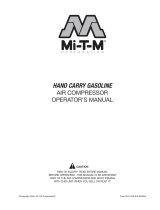
Troubleshooting
20 3A1696C
Bead guns not spraying Paint guns and bead guns If paint guns and bead guns are not working,
check paint guns first.
Bead tank air valve Turn bead tank valve ON
Nozzles plugged 1. Turn off air pressure.
2. Remove nozzles and clean out any plug-
ging.
3. If paper or other debris is constantly plug-
ging nozzles use a filter when loading
bead tank (standard window screen works
fine).
4. With nozzles removed, apply air to bead
tank. Spray beads into dry container.
5. Check if beads are wet. If beads are wet,
remove beads from bead tank and replace
with dry beads.
Solenoid valves 1. Go to diagnostic screen and check to see
if all solenoids are being recognized by
RoadPak Skipline Controller (manual
3A1215).
2. Remove solenoid valve cover (590).
3. Check for broken wiring or a damaged
plug (see Wiring Diagram, page 25).
4. Check for 12V DC between red wire and
ground.
Programmable Skipline Controller 1. Go to diagnostic screen and make sure all
switches are properly working (manual
3A1215).
2. Inspect wiring and plugs for damage.
3. Replace any damaged wiring or plugs
(manual 3A1301).
Actual line length not matching pro-
grammed line length
Out of calibration 1. Follow calibration in Programmable Skip-
line Controller manual 3A1215.
2. Spray one or two test skips and measure
actual length. If actual length is longer
than programmed length, increase Paint
Gun ON delay. If actual length is shorter
than programmed length, increase Paint
Gun OFF delay.
Actual cycle not matching programmed
cycle
Out of calibration Follow calibration procedure in Programmable
Skipline Controller manual 3A1215.
Bead guns not synchronizing with
paint guns
Out of calibration 1. Follow calibration in Programmable Skip-
line Controller manual 3A1215.
2. If beads start before paint, add delay time
to Bead ON Delay. If paint starts before
beads, add equal delay time to both Paint
ON and Paint OFF Delays (this does not
affect paint skip line length).
3. If beads end before paint, add delay time
to Bead OFF Delay. If beads end after
paint, add equal delay time to both Paint
ON, Paint OFF and Bead ON Delays. This
shifts everything forward.
PROBLEM CAUSE SOLUTION





















